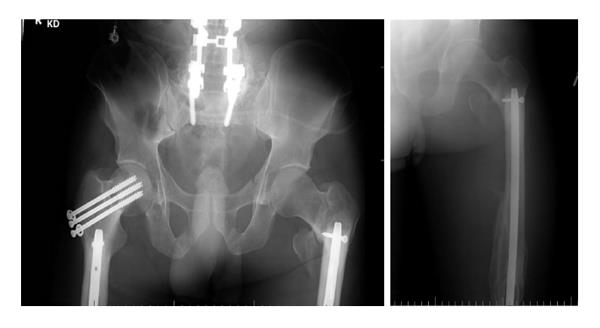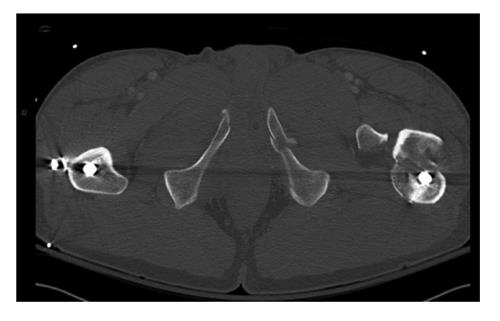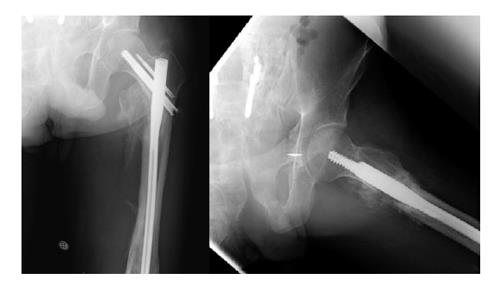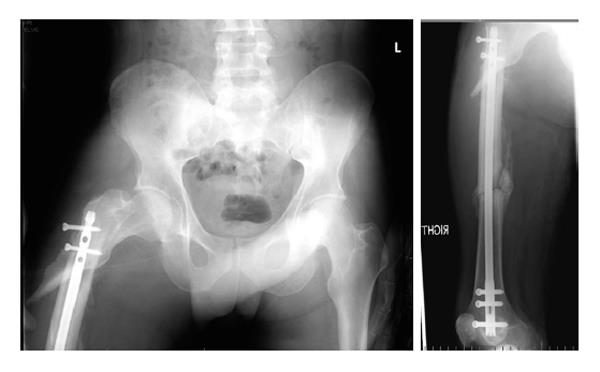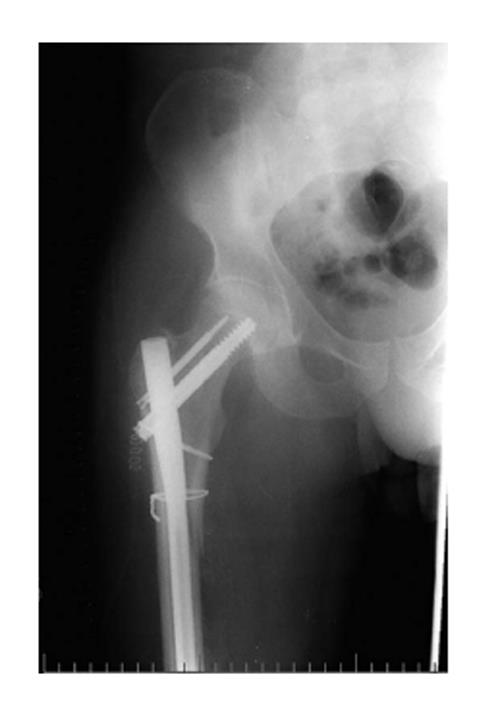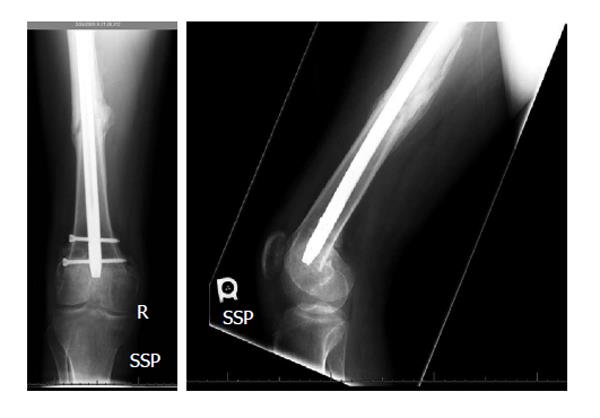Published online Oct 18, 2015. doi: 10.5312/wjo.v6.i9.738
Peer-review started: March 26, 2015
First decision: June 3, 2015
Revised: June 21, 2015
Accepted: July 21, 2015
Article in press: July 23, 2015
Published online: October 18, 2015
Processing time: 210 Days and 16.3 Hours
Secondary fractures around femoral nails placed for the management of hip fractures are well known. We report, two cases of a fracture of the femur at the interlocking screw site in the subtrochanteric area after retrograde femoral nailing of a femoral shaft fracture. Only a few reports in the existing literature have described these fractures. Two young men after sustaining a fall presented to us with pain, swelling and deformity in the upper thigh region. On enquiring, examining and radiographing them, peri-implant fractures of subtrochanteric nature through the distal interlocking screws were revealed in both patients who also had histories of previous falls for which retrograde intramedullary nailing was performed for their respective femora. Both patients were managed with similar surgical routines including removal of the existing hardware, open reduction and ace cephallomedullary antegrade nailing. The second case did show evidence of delayed healing and was additionally stabilized with cerclage wires. Both patients had uneventful postoperative outcomes and union was evident at the end of 6 mo postoperatively with a good range of motion at the hip and knee. Our report suggests that though seldom reported, peri-implant fractures around the subtrochanteric region can occur and pose a challenge to the treating orthopaedic surgeon. We suggest these be managed, after initial stabilization and resuscitation, by implant removal, open reduction and interlocking intramedullary antegrade nailing. Good results and progression to union can be expected in these patients by adhering to basic principles of osteosynthesis.
Core tip: The occurrence of peri-implant subtrochanteric fractures in patients operated previously by retrograde nailing for femoral diaphyseal fractures has been rarely reported. This case report provides the description of two such cases with subtrochanteric peri-implant fractures. These challenges are best met, according to our experience, by implant removal, open reduction and interlocking antegrade nailing.
- Citation: Mounasamy V, Mallu S, Khanna V, Sambandam S. Subtrochanteric fractures after retrograde femoral nailing. World J Orthop 2015; 6(9): 738-743
- URL: https://www.wjgnet.com/2218-5836/full/v6/i9/738.htm
- DOI: https://dx.doi.org/10.5312/wjo.v6.i9.738
Intramedullary nailing is the surgical treatment of choice in displaced diaphyseal femur fractures with excellent results reported in literature. Antegrade nailing either through the trochanter or the piriform fossa is the usual standard of treatment[1]. Retrograde intramedullary nailing of the femur was first reported by Green[2] in 1970. In the last two decades, a significant increase in the use of this technique has been witnessed in patients with difficult access to the proximal femur (obesity, bilateral femur fractures, ipsilateral pelvic fracture, hip fracture, tibia fracture and associated contralateral tibial plateau fractures which need internal fixation or staged external fixation). While knee pain and delay in union requiring dynamization have been reported with retrograde nailing, proclaimed benefits have included decreased blood loss and operative time and improved alignment when fixing distal femoral fractures[3-9].
Complications associated with nailing include implant failure, angulation, shortening, malunion and nonunion of the fracture with associated migration of the nail. While fractures at the distal end of a short intramedullary nail used to fix hip fractures are well known, peri-implant fractures of the proximal femur at the far end of a retrograde nail placed for a femoral shaft fracture as in our report have been infrequently reported[10-13]. We present a report of two patients sustaining a subtrochanteric fracture after retrograde femoral nailing.
A 33-year-old male presented to the emergency room with history of pain in his back and the left hip after sustaining a fall during skydiving. In a similar skydiving accident in the past, he had sustained bilateral femur fractures in addition to a burst fracture of the third lumbar vertebra. He had been operated for the same with bilateral retrograde femoral nails, cannulated screw fixation in the right femur and internal fixation of the L3 burst fracture.
In the current episode, he had sustained a peri-implant fracture of the left femur in the subtrochanteric region at the far end of the retrograde nail placed through the knee to manage his previous injury (Figure 1).
A computed tomography (CT) scan confirmed the fracture at the locking screw site. The fracture was through the distal of the two interlocking screw-containing holes at the subtrochanteric area. The patient elected operative intervention (Figure 2).
With the patient in a floppy lateral position on a bean bag under general anesthesia, we approached the knee through his previous midline incision and performed a medial parapatellar arthrotomy. The nail was identified and the interlocking screws at the lateral aspect of the femur were removed after connecting the jig to prevent rotation. The proximal screws were then removed through an anterior incision and the nail was extracted. The implants were intact on retrieval. The knee arthrotomy was closed in a routine manner after irrigation. The fracture site was exposed and reduced through a lateral incision over the proximal femur and a trochanteric entry Ace cephallomedullary nail was placed with two screws in the femoral neck and two distally at the knee in appropriate rotation.
He was advised toe-touch weight for 6 wk and then progressed to bear weight as tolerated with interval healing of the fracture. His fracture showed full union at six months postoperatively (Figure 3) and he had full range of movement of the hip and knee.
A 45-year-old male alcoholic presented to the emergency room with history of pain in his right hip after a fall. He had a history of internal fixation of right femur with a retrograde nail and internal fixation of a left tibial plateau 4 mo prior to this fall after being involved in a motor vehicle accident.
He sustained, similar to the previous patient, a peri-implant fracture of the right femur in the subtrochanteric region at the far end of the retrograde nail placed through the knee to manage his previous injury (Figure 4). The implants appeared intact on imaging.
A CT scan confirmed the fracture at the locking screw site and delayed union of the previously treated femoral shaft fracture (Figure 5).
The patient opted for operative intervention. The fracture was found to extend through the distal of the two interlocking screw holes at the subtrochanteric area. The patient was positioned and under general anesthesia, the right knee was approached through the previous incision. After a medial parapatellar arthrotomy, the nail was identified and the distal and proximal interlocking screws removed. The implants were intact on retrieval. After the extraction of the nail, the wound was closed as per routine.
Through a lateral incision over the proximal femur, the fracture site was exposed, reduced and held with two cerclage wires. A trochanteric entry Ace cephallomedullary nail was placed with two screws in the femoral neck and two distally at the knee in a manner similar to the first case (Figure 6).
Postoperative management was identical to the previous patient. During the last office visit at six months postoperatively, he was full weight bearing on his right lower extremity and had near full range of motion at the hip and knee. Radiographs showed a healed subtrochanteric as well as the shaft fracture with no loss of alignment (Figures 7 and 8).
After its first description nearly four and a half decades back, retrograde intramedullary nailing has been often employed for femoral diaphyseal or supracondylar fractures associated with ipsilateral tibia and/or patella fractures. It is also a useful modality in diaphyseal fractures of femur associated with ipsilateral femoral neck fracture as well as acetabular fractures. In pregnancy, it proves advantageous over the antegrade nail by limiting radiation exposure to abdomen. In a polytrauma patient with multiple fractures and obese patients with bilateral femoral diaphyseal fractures, the retrograde nail negates the necessity of a fracture table or any special positions[3-9]. At our center, we perform around 75 retrograde femoral nails per year.
In a prospective randomized controlled trial, Ostrum et al[3] compared the results, function, and complications of antegrade and retrograde femoral nailing for femoral shaft fractures in one hundred consecutive patients and concluded that both groups yielded high union rates. Knee pain was common in both the groups while antegrade nailing patients complained of thigh pain. They also noted that antegrade nailed femurs healed faster and a few retrograde nailed patients needed dynamization to achieve union.
In a paper on proximal femoral fractures associated with ipsilateral shaft fractures managed by hip screws and reamed retrograde intramedullary nails, Ostrum et al[4] reported union rates of 98% and 91.3% for the femoral neck and shaft fractures respectively. In a systematic review of literature, Papadokostakis et al[14] analyzed retrograde nailing of 544 femoral shaft fractures and observed an overall union rate of 94.6% and a mean time to union of 3.2 mo. They reported that 24.5% patients had knee pain and 17.7% of patients needed reoperations for screw related issues or to achieve union. Though none of them had proximal implant related fractures, 7.4% patients had malunion and the infection rate was 1.1%.
Our second case did show evidence of delayed union following both surgeries. In a case-control study by Taitsman et al[15], identified risk factors for nonunion after femoral nailing of diaphyseal femur fractures were open fractures, tobacco use and delayed weight bearing. Modalities of managing femoral nonunions following nailing have included exchange nailing, plating and augmentative locking plating. All of these have shown excellent results[16-18]. In a recent retrospective cohort study, Swanson et al[16] described various strategies of exchange nailing for femur nonunions with nail in-situ including larger nails (at least 2 mm larger in diameter), nails from a different manufacturer, static interlocking, correction of metabolic and endocrine disorders and secondary dynamization.
Koval et al[19] reported that any drill hole that occupies 20% of the diameter weakens the bone by 40% and that 90% of fractures around fixation implants occur through a drill hole. Proximal-end fractures after retrograde femoral nailing have been reported in the past[12,13] (Table 1). Leibner et al[12] reported one case of a femoral fracture at the proximal end of an intramedullary supracondylar nail and concluded that it may be due to the proximal end acting as a stress riser and cortical holes drilled for the interlocking screw placement increasing the risk for failure. In their case report, the patient had a supracondylar nail placed for a distal third femur fracture and secondary fracture occurred in the diaphysis of the femur[12]. In another case report by O'Mara et al[13], a 61-year-old lady presented a month after sustaining a pertrochanteric fracture at the tip of a retrograde femoral nail 4 mo postoperatively with evidence of incomplete bridging callus at the index fracture shaft of the femur. She was managed by fracture reduction with traction and fixation with a 95° angled blade plate. The retrograde nail was left in situ. The authors reported a good outcome 1.5 years postoperatively.
Norris et al[10] reported secondary fracture around femoral nails used to treat hip fractures and noted a slight decrease in the same when longer nails were used in comparison to short nails. The overall incidence was around 1.7%. Biaxial fixation compared to uniaxial fixation had a significantly lower risk of fracture. Further, emerging design changes have decreased the incidence of secondary fractures.
Iatrogenic femoral neck fractures during insertion of antegrade nails have been reported. These may be due to wrong insertion site, forceful insertion, multiple entry points, excessive lateral entry point and oblique insertion of the nail[20,21]. Parker et al[22] identified several factors responsible for peri-implant fractures including traumatic, stress, iatrogenic, avascular necrosis, implant failure and pathologic causes. These fractures were common in the elderly, osteopenic population. To avoid fatigue failure, multiple and larger diameter screws were added[23].
Mounasamy et al[24] reported two cases of a peri-implant fracture through distal interlocking screw site after fresh trauma, in patients who had previous intra-medullary implant.
We are unsure why these fractures occurred in our patients. Metabolic and osteoporotic parameters of both patients were within normal limits. A probable explanation could be the presence of stress risers at the proximal end of the nail and screw holes. We preferred antegrade nailing with cephallomedullary screw fixation to manage both these secondary fractures in view of the location of both these fractures at the subtrochanteric level. Additionally, the second patient had delayed union of his previously treated femur fracture, which was addressed with reaming and a larger diameter nail.
Other treatment options to manage these fractures would be the use of proximal femoral locking plates, angled blade plates or the dynamic condylar screw plate device. Antegrade intramedullary nailing is the treatment of choice for subtrochanteric femur fractures[25]. The proximal fragment in a subtrochanteric fracture is displaced in flexion, abduction and external rotation. Afsari et al[26] have reported a high rate of union of subtrochanteric femur fractures treated with open clamp reduction and intramedullary nailing. They also reported that the subtrochanteric region has cortical bone with less vascularity and healing potential as compared to the intertrochanteric region.
To our knowledge, there is no consensus in the current literature regarding fracture at the far end of the retrograde nail placed to treat a femoral shaft fracture. We suggest the removal of the retrograde nail, if the fracture has healed anatomic reduction of subtrochanteric fracture and fixation with antegrade intramedullary nail.
Two patients presented with pain, swelling and deformity of the upper thigh following an injury.
Fracture proximal one third of the femur.
Subtrochanteric fracture, fracture shaft of femur, fracture neck of femur, intertrochanteric fracture femur.
Case 1: Peri-implant fracture of the left femur in the subtrochanteric region at the far end of the retrograde nail confirmed by a computed tomography (CT) scan; Case 2: Peri-implant fracture of the right femur in the subtrochanteric region at the far end of the retrograde nail and delayed union of the previously treated femoral shaft fracture confirmed by a CT scan.
Case 1: Implant removal, open reduction and interlocking antegrade femoral nailing; Case 2: Implant removal, open reduction, cerclage wiring and interlocking antegrade femoral nailing.
This case report of two patients not only represents an unusual pattern of peri-implant femoral shaft fracture, but also confirms the excellent outcome following the management of these cases by antegrade nailing.
The authors have performed a good study, the manuscript is interesting.
P- Reviewer: Angelini A, Franklyn MJ, Maheshwari AV, Seijas R S- Editor: Tian YL L- Editor: A E- Editor: Liu SQ
| 1. | Brumback RJ, Uwagie-Ero S, Lakatos RP, Poka A, Bathon GH, Burgess AR. Intramedullary nailing of femoral shaft fractures. Part II: Fracture-healing with static interlocking fixation. J Bone Joint Surg Am. 1988;70:1453-1462. [PubMed] |
| 2. | Green S. Distal intramedullary fixation of supracondylar fractures of femur. Techniques Orthop. 1988;3:71-76. [RCA] [DOI] [Full Text] [Cited by in Crossref: 21] [Cited by in RCA: 20] [Article Influence: 0.5] [Reference Citation Analysis (0)] |
| 3. | Ostrum RF, Agarwal A, Lakatos R, Poka A. Prospective comparison of retrograde and antegrade femoral intramedullary nailing. J Orthop Trauma. 2000;14:496-501. [RCA] [PubMed] [DOI] [Full Text] [Cited by in Crossref: 131] [Cited by in RCA: 104] [Article Influence: 4.2] [Reference Citation Analysis (0)] |
| 4. | Ostrum RF, Tornetta P, Watson JT, Christiano A, Vafek E. Ipsilateral proximal femur and shaft fractures treated with hip screws and a reamed retrograde intramedullary nail. Clin Orthop Relat Res. 2014;472:2751-2758. [RCA] [PubMed] [DOI] [Full Text] [Cited by in Crossref: 37] [Cited by in RCA: 40] [Article Influence: 3.6] [Reference Citation Analysis (0)] |
| 5. | Ricci WM, Gallagher B, Haidukewych GJ. Intramedullary nailing of femoral shaft fractures: current concepts. J Am Acad Orthop Surg. 2009;17:296-305. [PubMed] |
| 6. | Ostrum RF. Treatment of floating knee injuries through a single percutaneous approach. Clin Orthop Relat Res. 2000;43-50. [RCA] [PubMed] [DOI] [Full Text] [Cited by in Crossref: 49] [Cited by in RCA: 52] [Article Influence: 2.1] [Reference Citation Analysis (0)] |
| 7. | Gregory P, DiCicco J, Karpik K, DiPasquale T, Herscovici D, Sanders R. Ipsilateral fractures of the femur and tibia: treatment with retrograde femoral nailing and unreamed tibial nailing. J Orthop Trauma. 1996;10:309-316. [RCA] [PubMed] [DOI] [Full Text] [Cited by in Crossref: 78] [Cited by in RCA: 57] [Article Influence: 2.0] [Reference Citation Analysis (0)] |
| 8. | Ricci WM, Bellabarba C, Evanoff B, Herscovici D, DiPasquale T, Sanders R. Retrograde versus antegrade nailing of femoral shaft fractures. J Orthop Trauma. 2001;15:161-169. [RCA] [PubMed] [DOI] [Full Text] [Cited by in Crossref: 120] [Cited by in RCA: 109] [Article Influence: 4.5] [Reference Citation Analysis (0)] |
| 9. | Sanders R, Koval KJ, DiPasquale T, Helfet DL, Frankle M. Retrograde reamed femoral nailing. J Orthop Trauma. 1993;7:293-302. [RCA] [PubMed] [DOI] [Full Text] [Cited by in Crossref: 88] [Cited by in RCA: 72] [Article Influence: 2.3] [Reference Citation Analysis (0)] |
| 10. | Norris R, Bhattacharjee D, Parker MJ. Occurrence of secondary fracture around intramedullary nails used for trochanteric hip fractures: a systematic review of 13,568 patients. Injury. 2012;43:706-711. [RCA] [PubMed] [DOI] [Full Text] [Cited by in Crossref: 121] [Cited by in RCA: 109] [Article Influence: 8.4] [Reference Citation Analysis (0)] |
| 11. | Williams J, Gibbons M, Trundle H, Murray D, Worlock P. Complications of nailing in closed tibial fractures. J Orthop Trauma. 1995;9:476-481. [RCA] [PubMed] [DOI] [Full Text] [Cited by in Crossref: 59] [Cited by in RCA: 50] [Article Influence: 1.7] [Reference Citation Analysis (0)] |
| 12. | Leibner ED, Mosheiff R, Safran O, Abu-Snieneh K, Liebergall M. Femoral fracture at the proximal end of an intramedullary supracondylar nail: a case report. Am J Orthop (Belle Mead NJ). 1999;28:53-55. [PubMed] |
| 13. | O’Mara T, Barei DP, Taitsman LA, Vallier H, Chapman JR. Pertrochanteric femur fracture at the proximal end of a retrograde intramedullary nail-a case report. Injury Extra. 2005;36:271-276. [RCA] [DOI] [Full Text] [Cited by in Crossref: 2] [Cited by in RCA: 3] [Article Influence: 0.2] [Reference Citation Analysis (0)] |
| 14. | Papadokostakis G, Papakostidis C, Dimitriou R, Giannoudis PV. The role and efficacy of retrograding nailing for the treatment of diaphyseal and distal femoral fractures: a systematic review of the literature. Injury. 2005;36:813-822. [RCA] [PubMed] [DOI] [Full Text] [Cited by in Crossref: 84] [Cited by in RCA: 65] [Article Influence: 3.3] [Reference Citation Analysis (0)] |
| 15. | Taitsman LA, Lynch JR, Agel J, Barei DP, Nork SE. Risk factors for femoral nonunion after femoral shaft fracture. J Trauma. 2009;67:1389-1392. [RCA] [PubMed] [DOI] [Full Text] [Cited by in Crossref: 57] [Cited by in RCA: 63] [Article Influence: 4.2] [Reference Citation Analysis (0)] |
| 16. | Swanson EA, Garrard EC, Bernstein DT, OʼConnor DP, Brinker MR. Results of a systematic approach to exchange nailing for the treatment of aseptic femoral nonunions. J Orthop Trauma. 2015;29:21-27. [RCA] [PubMed] [DOI] [Full Text] [Cited by in Crossref: 33] [Cited by in RCA: 32] [Article Influence: 3.2] [Reference Citation Analysis (0)] |
| 17. | Chen SB, Zhang CQ, Jin DX, Cheng XG, Sheng JG, Zeng BF. Treatment of aseptic nonunion after intramedullary nailing fixation with locking plate. Orthop Surg. 2009;1:258-263. [RCA] [PubMed] [DOI] [Full Text] [Cited by in Crossref: 1] [Cited by in RCA: 2] [Article Influence: 0.2] [Reference Citation Analysis (0)] |
| 18. | Ye J, Zheng Q. Augmentative locking compression plate fixation for the management of long bone nonunion after intramedullary nailing. Arch Orthop Trauma Surg. 2012;132:937-940. [RCA] [PubMed] [DOI] [Full Text] [Cited by in Crossref: 13] [Cited by in RCA: 15] [Article Influence: 1.2] [Reference Citation Analysis (0)] |
| 19. | Koval KJ, Frankel VH, Kummer F, Green S. Complications of fracture fixation devices. Complications in Orthopaedic Surgery. 3rd ed. Philadelphia, Pa: JB Lippincott 1994; 131-154. |
| 20. | Khan FA, Ikram MA, Badr AA, al-Khawashki H. Femoral neck fracture: a complication of femoral nailing. Injury. 1995;26:319-321. [RCA] [PubMed] [DOI] [Full Text] [Cited by in Crossref: 31] [Cited by in RCA: 28] [Article Influence: 0.9] [Reference Citation Analysis (0)] |
| 21. | Christie J, Court-Brown C. Femoral neck fracture during closed medullary nailing: brief report. J Bone Joint Surg Br. 1988;70:670. [PubMed] |
| 22. | Parker MJ, Handoll HH. Gamma and other cephalocondyltic intramedullary nails versus extramedullary implants for extra capsular hip fractures in adults. Cochrane Database Syst Rev. 2010;8:CD000093. |
| 23. | Griffin LV, Harris RM, Zubak JJ. Fatigue strength of common tibial intramedullary nail distal locking screws. J Orthop Surg Res. 2009;4:11. [RCA] [PubMed] [DOI] [Full Text] [Full Text (PDF)] [Cited by in Crossref: 20] [Cited by in RCA: 22] [Article Influence: 1.4] [Reference Citation Analysis (0)] |
| 24. | Mounasamy V, Desai P. Peri-implant fracture of the distal tibia after intra-medullary nailing of a tibial fracture: a report of two cases. Eur J Orthop Surg Traumatol. 2013;23 Suppl 2:S279-S283. [PubMed] |
| 25. | DiCicco JD, Jenkins M, Ostrum RF. Retrograde nailing for subtrochanteric femur fractures. Am J Orthop (Belle Mead NJ). 2000;29:4-8. [PubMed] |
| 26. | Afsari A, Liporace F, Lindvall E, Infante A, Sagi HC, Haidukewych GJ. Clamp-assisted reduction of high subtrochanteric fractures of the femur. J Bone Joint Surg Am. 2009;91:1913-1918. [RCA] [PubMed] [DOI] [Full Text] [Cited by in RCA: 1] [Reference Citation Analysis (0)] |









